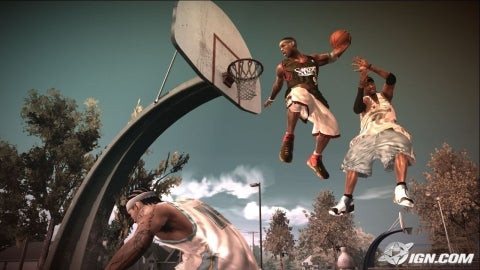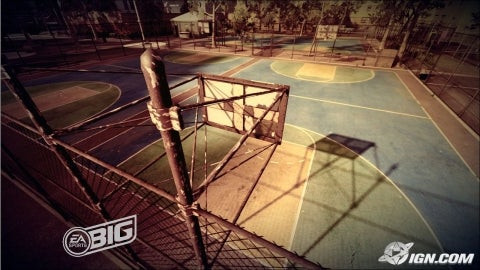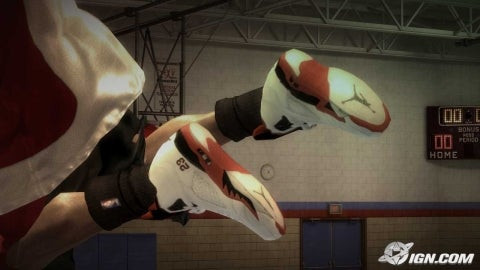Arcade sports games have always held a special place in gaming culture, offering over-the-top action and instant gratification. Among them, the Nba Street series has carved a unique niche by capturing the essence of streetball – raw, stylish, and full of personality. NBA Street Homecourt, developed by EA Canada, aimed to redefine the genre, promising a more organic and realistic streetball experience. Did it live up to the hype? Let’s delve into what made this title a standout in the NBA Street franchise and the broader arcade sports landscape.
 NBA Street Homecourt gameplay, showcasing realistic street basketball action on Xbox 360.
NBA Street Homecourt gameplay, showcasing realistic street basketball action on Xbox 360.
Gameplay Revolution: The Trick Remixer and Gamebreaker System
One of the most significant advancements in NBA Street Homecourt was the introduction of the Trick Remixer. This innovative control system moved away from pre-canned animations and towards a more fluid and player-driven trick execution. With simple button presses and modifier combinations, players could seamlessly chain together crossovers, behind-the-back dribbles, pirouettes, and a variety of other streetball moves. The Trick Remixer empowered players to express their creativity and develop unique playstyles on the court, moving beyond repetitive button-mashing that plagued some earlier arcade sports titles.
 NBA Street Homecourt Trick Remixer in action, allowing players to create highlight reel moments with stylish dribbling moves.
NBA Street Homecourt Trick Remixer in action, allowing players to create highlight reel moments with stylish dribbling moves.
Complementing the Trick Remixer was the Gamebreaker meter. Unlike previous iterations with canned super dunks, Homecourt implemented a meter that filled as players successfully executed tricks and combos. Once full, players could unleash devastating Gamebreaker dunks, adding a strategic layer to the gameplay. For an even more spectacular finish, the Trifecta – a triple-gamebreaker dunk achieved by launching off a teammate – offered a high-risk, high-reward move that could instantly shift momentum. This system encouraged skillful play and rewarded players for mastering the trick system, making each game feel dynamic and exciting.
Balanced Court Action: Offense and Defense
NBA Street Homecourt also refined the defensive aspects of streetball. Defense was no longer an afterthought but an integral part of the gameplay loop. Players had tools to challenge ball handlers through steals and physical shoves, forcing turnovers and disrupting offensive flow. A well-timed block could be as impactful as a flashy dunk, especially considering the game’s emphasis on goaltending rules, mirroring the reality of streetball where protecting the rim is crucial.
The game featured four player types – guards, forwards, centers, and WNBA players – each with unique dunk styles and attributes. While powerful dunks were a staple, the game also acknowledged the finesse of lay-ups and the diverse skillsets within basketball. The inclusion of WNBA players, although some felt their dunking abilities were underrepresented, added a layer of inclusivity and broadened the roster beyond typical NBA lineups.
Homecourt Challenge: Stepping into the Streetball World
The single-player campaign, Homecourt Challenge, provided a narrative-driven experience where players created a custom baller and progressed through various real-world streetball courts across the United States. From iconic locations like Rucker Park to local gems, each court offered a unique atmosphere and set of challenges. Unlocking Air Jordan apparel and shoes, and leveling up the created player, provided a sense of progression and customization that kept players engaged.
 Street basketball court in NBA Street Homecourt, representing the urban setting of the Homecourt Challenge.
Street basketball court in NBA Street Homecourt, representing the urban setting of the Homecourt Challenge.
However, the Homecourt Challenge was not without its critics. Some felt it lacked the depth of a true “homecourt” experience. The absence of rivalries, court ownership dynamics, and a more compelling storyline left some players wanting more in terms of immersion and streetball culture. Despite these shortcomings, the campaign provided a solid single-player mode that complemented the core arcade gameplay.
Visuals, Sound, and Multiplayer: Polishing the Package
Graphically, NBA Street Homecourt was a significant leap forward. Running at a smooth 60 frames per second, the game showcased fluid animations and detailed player models. The visual fidelity enhanced the overall sense of realism and responsiveness, making the on-court action visually captivating. The soundtrack, a blend of funk, soul, and hip-hop, perfectly captured the streetball vibe, while the in-game sound effects, including player chatter and court sounds, added to the immersive atmosphere.
Multiplayer was a core strength of the NBA Street series, and Homecourt continued this tradition. Offering pick-up games, Gamebreaker battles, and trick battles, the game provided a range of competitive modes for online and local play. While some desired more advanced online features like a “defend-your-turf” mode, the core multiplayer experience remained engaging and replayable.
 Customizable character wearing Air Jordan shoes in NBA Street Homecourt, showcasing unlockable gear in the game.
Customizable character wearing Air Jordan shoes in NBA Street Homecourt, showcasing unlockable gear in the game.
Conclusion: A High Point for NBA Street
NBA Street Homecourt stands as a high point in the NBA Street series and a notable achievement in arcade sports gaming. Its innovative Trick Remixer and Gamebreaker systems revolutionized the gameplay, offering depth, creativity, and strategic elements. While the single-player campaign and online features had room for expansion, the core on-court action, coupled with impressive graphics and sound, delivered a compelling streetball experience. For fans of arcade basketball and the NBA Street franchise, Homecourt remains a must-play title that captures the energy and style of streetball culture.
